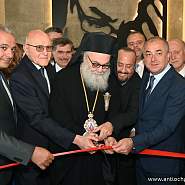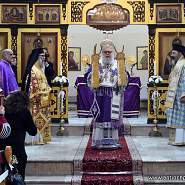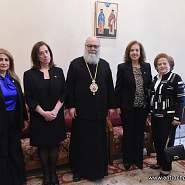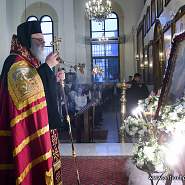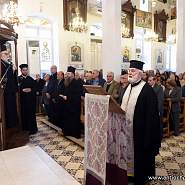The Mother of God Iconography
The Mother of God Iconography
1- The Theology of the Icon of the Mother of God:
The meaning of the name “Mother of God” implies all the mystery of God’s salvation for humankind, as expressed by the great iconodule, Saint John of Damascus.
This name indicates precisely the most important event in human history: that the divine nature was united with the human nature. It is therefore the salvation of humankind from corruption and sin.
It is true that the term “Mother of God” was confirmed in the Third Ecumenical Council, held in Ephesus in 431 CE, but its spiritual connotation is at the core of the Christian faith. Do we not say in the first part of the Creed of the First Ecumenical Council in 325 CE that “the Son of God was incarnate from the Holy Spirit and the Virgin Mary”?
Likewise, we must not lose sight of what Elizabeth said to the Virgin when Mary came to attend to her immediately after the gospel: “So where does this mother of my Lord come to me Mήτηρ τοῦ Κυρίου” (Luke 1:43)?
Alexandros of Alexandria (313-326 CE) used this terminology before the Third Council, and St. Gregory of Nazianzus (+ 380 AD) said, “Anyone who does not say that Mary is the Mother of God THEOTOKOS θεοτόκος is cursed.
The word θεοτόκος is a combination of θεός i.e. God and Τόκος (born) of the verb τίκτω and means giving birth, i.e. the embryo comes out of the womb and hence, she became the Virgin Mary θεοτόκος, i.e. She is the Mother of the God who is inseparable in his divine and human natures, and not Χριστοτόκος: Mother of Christ as Nestorius claimed when he fell into heresy.
The Lord Jesus Christ was born not made, meaning that he was not born of a human father nor was he fashioned by a human hand, but rather He is perfect God begotten by God the Father outside of time, and when he was incarnated he also became a perfect Human Being, born of the Virgin Mary within time. He combined with his incarnation the human nature with the divine nature.
2- The Mother of God in the Bible:
Between the first and the last books of the Bible, i.e. the Book of Genesis and the Book of Revelation, we learn about the Virgin Mary, the woman of great offspring, the Mother of Jesus Christ, the same Jesus who crushed the head of the serpent. We also meet the woman garbed with the sun with the moon under her feet, and a crown of twelve stars on her head (Revelation 1:12).
3- The Mother of God and Holiness:
Just as God became man so that man might become god, Mary is the fruit of holiness in the Old Testament, and the door to the New Testament. She is not only the New Eve, but also the prototype of holiness for those who imitate her words in response to God's call when she said to the angel: “Behold, I am the servant of the Lord, let it be according to your words.”
Mary's answer is the outline for deification (theosis). God calls and humans say: Amen.
There is no other source of holiness than God. Therefore, Mary uttered this prayer while praising the Lord: “My soul magnifies the Lord and my Spirit rejoices in God my Savior” (Luke 1: 46).
4- What the Mother of God Says in the Icon:
God is the only Savior. There is no other Savior to come near. As we come near the icon of the Mother of God, we listen to the words of John the Evangelist: Look at the Word who was in the Beginning. Without Him nothing was made that was made. In Him was life, and the life was the light of men (John 1:3-5).
Indeed, this is the God that the Virgin Mary bears in her arms: He is the Almighty Lord who made great things by her, God who was willing to be born from the womb of a pure woman.
Mary continues with the beloved disciple, and declares: “The Word became flesh and dwelt among us” (John 1:14). She tells us about what her hands touched, so that we may have communion with him and the joy of Heaven will be complete.
5- Mother of God and the Mystery of the Incarnation
Here is the whole mystery. How can the Creator become a man? Each icon of the Mother of God is the answer, and these icons lead us on a coherent process of faith which starts from the moment Mary enters the temple and dedicates herself to God since her childhood and continues to the moment she gives birth to her only son. It includes the Annunciation, the songs of the angels, and the words of the prophets in the Old Testament, specially the words of Isaiah the prophet, who says in his great sign: "Behold, the virgin conceives, gives birth to a son, and calls his name Emmanuel, that is, God is with us."(7:14)
We complete the process with the prophecy of Simeon also declaring: "Behold, our eyes have seen Your salvation which You have prepared before the face of all peoples, a light to bring revelation to the Gentiles,
and the glory of the victorious and triumphant people." We do not only join Anna the prophetess as awaiting the Lord’s redemption and salvation, but we also admit that this redemption was fulfilled.
Despite Mary’s continuous silence, we see
her inviting all of us with a loud voice repeating what she said to the servants at the wedding of Cana of Galilee: “Whatever He says to you, do it” (John 2:5).
Blessed is he who listens to this word, puts it in practice and grows by it until he will be deified. She is the great witness, more honorable than the Cherubim, who stands before us, carrying in her arms the One who cannot be held by the whole universe.
This miraculous birth came as an expression of her pure life, her patience, her struggle, her humility and her purity. As much as God wanted to be incarnate, He wanted the Virgin to accept this incarnation in her full will because He does not impose Himself nor eliminates the human will and freedom. As for Mary, she willfully accepted to be the Mother of God.
If take a closer look at the icon of the Mother of God, we would be enthralled, full of wonder and joy.
Mary, as human being, presents God incarnate to humankind.
She asks the viewer of her icon to partake in this acceptance of God and to incarnate Him in life. Could there be a higher call? Are we prepared for this great glory?
In this context, St. Nicholas Cabasilas expressed the following: "The incarnation is not only the work of the Holy Trinity, but also of the fruit of the Virgin’s will and faith."
Thus, accepting this incarnation in our lives requires listening to the word of God, humility and emptying of oneself.
The Saint also continues: “When God looked at Mary, he could only be incarnate from her.”
If we ask how this was done, the liturgy comes to give us the answer, and says: "The Son was born without a father, this God is born from the Father without a mother."
6- Going Deep and Giving Honor to the Mother of God:
Anyone who is contented with the external features in the icon of the Mother of God without passing on to the real divine and perfect beauty, to the Holy of Holies, is wrong.
This beauty cannot be perceived if we remain standing outside, looking with our earthen eyes without the soul.
Here the question arises: What can we say to the one who keeps himself away from this paradise, clinging to biblical arguments filled with the letters that have been deprived of soul?
Or how shall we answer someone who was swept away by a heresy, pretending real knowledge while being a blind man leading blind men and then both fall in the pit?
One who loses a mother in this life understands the weight of her absence, how much more when making oneself an orphan by boasting about bible comprehension, while another person is completely lost in the difference between worship and honor?
The righteous glorification can only take place in prayer, compunction, and fasting. Then it is possible for us to cry out with Elizabeth, saying: “Blessed are you among women, and blessed is the fruit of your womb! But why is this granted to me, that the mother of my Lord should come to me? (Luke 1:42-43)
There is no way to find the answer outside the divine plan and the unlimited love of God for mankind.
God takes the initiative; whoever accepts that He was incarnate also accepts the one from whom He was incarnate. There is beautiful harmony between honoring the Mother of God and worshipping the Lord; it forms a secret that human minds do not fathom.
“What do we offer you, O Christ, God? Heaven brings to you the angels, and the earth offers its goods for you, but we offer you a Virgin Mother.”
This hymn is chanted by the faithful on the eve of the Feast of Nativity; it expresses the honor and majesty felt by all the faithful of the Church who have realized the meaning of Mary’s words: “All generations shall call me blessed.”
This honor comes in the form of Jesus’ last request on the Cross: “This is your mother (John 19: 27), presenting his Mother to every beloved disciple.
Therefore, the icon becomes a theological presence that accompanies the Lord’s presence in our lives and highlights all the events of salvation, from the first creation to the new creation. It reveals that Mary is not any other woman. She represents every human in the universe. Through her the world is called to be filled with the Holy Spirit and consequently give birth to the Savior.
This is precisely what the Lord Jesus meant when he said: “For whoever does the will of My Father in heaven is My brother and sister and mother.” (Matthew 12:50)
And who in this world inhabited the Divine will more than the Mother of God?
The greatness of Mary lies in that she always listened to the word of God and kept it in her heart, until she united with it. This is expressed by the word "Ipakoi", meaning “listening”, in complete obedience to the word of God.
Hence the saying: “Be Marian to be saved.” There is no error here, because the true meaning of this phrase is that grace was given to every human being to give birth to Christ in his life and in the lives of others.
The one who gives birth to Christ becomes himself a Christ.
7- The Mother of God calls us:
The icon of the Mother of God invites us to reflect upon the union of the divine nature with human nature. We see this incarnate in Jesus Christ. She leads us to Christ.
The Virgin leads the faithful as they follow her. She has preceded us by giving birth to the Savior and in her Dormition. The Lord raised her, and so she passed the death that was conquered by her son, after he was risen on the third day. We call upon her intercession from generation to generation.
" At Your right hand stands the queen in gold from Ophir” (Psalms 45:9).
8- The Icon of the Mother of God on the iconostasis:
In Orthodox Churches, the icon of the Mother of God is at the right (northern) side of the icon of the Lord. She is holding the Lord Jesus in her arms. The priest or deacon comes out of the altar during Matins to declare aloud in front of the Beauty doors with much reverence and contrition: “Let us honor and magnify in song the Theotokos and the Mother of light.”
Then he goes out carrying the censer to incense every person present in the church as being a project of holiness. Then the choir begins by chanting what is known in the liturgy of the Orthodox Church as the ninth ode. This liturgical arrangement stems from the Church's belief in the intercession of Mary and her position in the Church.
9- Common and General Characteristics of icons of the Mother of God:
The Mother of God is presented in the icon through the Greek characters MP ΘY, that stand for Mήτηρ Θεού i.e. the Mother of God. She can also be referred to as Θεομήτωρ.
- Beauty:
There is no earthly but a divine beauty in the icon, far from the standards of human comeliness. It is the beauty of light and divine grace that is poured out on the saint, so how much more is the mother of God who is full of grace.
- Colors in the Icon of the Mother of God:
We often see the Mother of God wearing a wine-red color on the outside and blue on the inside. The wine-red color symbolizes divine glory and blue symbolizes creation, while the Lord Jesus wears the opposite, as God incarnate, who put on human nature. These colors express the economy of salvation that God provided for humankind and God’s call for us to reach deification. This is what the Church realized from the beginning, and the Holy Fathers made it very clear. For example, we read what St. Didymus the Blind said: “God has become a man, so that a man can become a god.”
This is the goal of divine incarnation, to become gods by grace.
Once we look at the icon of our Lord and our Lady, we understand what we are called to and then we chant with Paul the apostle: “Aas any as have been baptized into Christ have put on Christ (Galatians 3:27).
-The Clothing:
The Mother of God wears a long veil called the Maphorion, which covers her head and shoulders. It is also embroidered with gold, so that we remember the psalm: “Woven with the gold of her clothes” (Ps. 13:45).
- The Stars:
The three stars indicate the virginity of the Mary before, during and after birth-giving.
In the history of ancient pictorial art, these stars were used for kings and rulers to symbolize transcendence, divine descent, power, and sovereignty.
But all of these attributes took on a new meaning with Mary. Although she became the mother of God, Mary remained an example of humility, emptying of self, meekness, and service, and here is precisely her holiness.
-The Halo:
The head of the Mother of God is always surrounded by a halo use for all the saints to indicate holiness. Every human being is called to this holiness like her. Indeed, she is "the most holy of all saints". This is why we call her Παναγια Panaghia."
- The Face:
We always notice that the mouth is small and closed because it is God who speaks. The nose is long because it breathes the scent of the kingdom and the eyes roam in prayer and contemplate the word of God.
10- The Four Main Icon Prototypes of the Mother of God:
- The Glorious Virgin of Kyriotissa
- The Virgin of Intercession (The Virgin of the Sign, the Orante known as Platytera "More spacious than the heavens”)
- Virgin Hodigitria
- The Merciful Virgin Eleousa
We will provide a later explanation for each icon in terms of its history and meanings.
In icons, Jesus’ face is far from the common child known, to indicate his divinity. The sober face of Jesus reflects divine glory and majesty, being “The image of the invisible God.” (Colossians 1:15)
“And without controversy great is the mystery of godliness: God was manifested in the flesh, justified in the Spirit, Seen by angels, preached among the Gentiles, believed on in the world, received up in glory.” (1 Timothy 3:16)
He is the Incarnate Word Who brings salvation to all humankind and is called “Emmanuel”, meaning God is with us. He is garbed with the adults’ robe of his times called Himation.
The color of the fiery garment inlaid with pure gold is an indication that He is the Never-setting Sun. It is the same garment that we see in the icon of the Ascension.
The Orthodox Church stresses the necessity to depict the Mother of God with the Lord Jesus in her icons to assert that He is the Savior, and Mary's role is derived from the importance of this Savior whom she holds in her arms.
However, we find icons of the Mother of God where she is alone without the Lord Jesus in the following cases:
1- Icons depicting events from the life of the Mother of God as a child or with her parents:
- The Icon of Saint Anne with her daughter Mary.
- The icon of Mary between Joachim and Anne.
- The icon of the Nativity of the Theotokos.
- Icon of entrance of the Mother of God into the Temple.
2- The icon of intercession, which consists of the Lord Jesus Christ in the center and the mother of God on his right, and Saint John the Baptist on his left, both of whom raise their hands, pray, and intercede.
3 - Certain salvific events where the Virgin Mary is honored because she is the Mother of God:
The Icon of the Annunciation.
- The Icon of the Myrrh-bearing Women.
- The icon of the Ascension.
- In some icons of the Pentecost.
4- The Abbess of Mount Athos Icon of the Mother of God
Through the intercession of the Most Holy Theotokos O Savior save us.

2024-04-18
2024-04-14
Sunday Liturgy of Saint John…
2024-04-12
His Beatitude Receives a…
2024-04-12
The Fourth Akathist Prayer in…
2024-04-11
Great Compline Prayer in Jdeidat…



